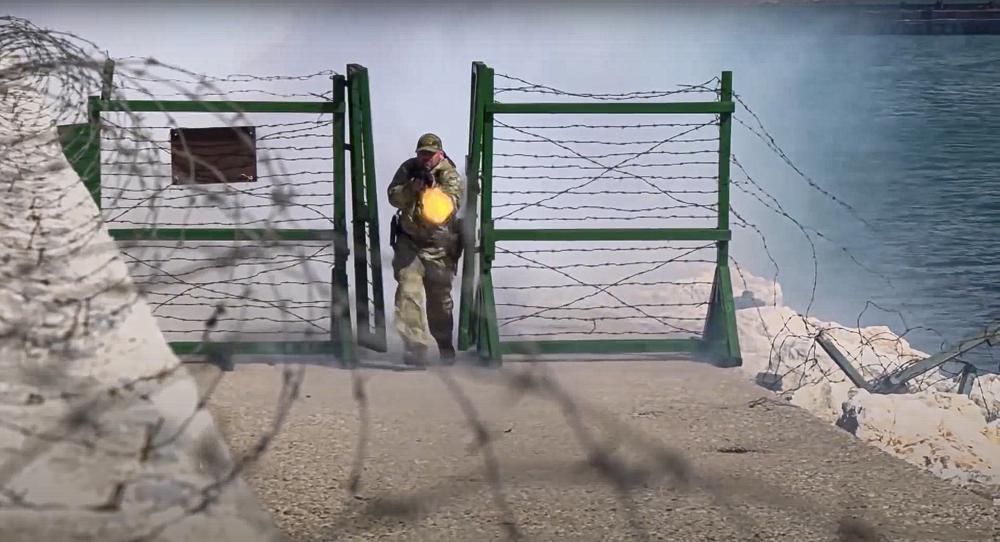Russia said Wednesday it was returning more troops and weapons to bases, but NATO declared it saw no sign of a drawdown as fears that Moscow could invade Ukraine soon persisted.
Russia has massed about 150,000 troops east, north and south of Ukraine, sparking Western concerns it was planning an attack. Moscow denies it has any such plans and this week said it was pulling back some forces and weapons, though it gave few details. Those claims have been met with skepticism from the U.S. and its allies — even as they seemed to lower the temperature following weeks of escalating East-West tensions.
On Wednesday, the Russian Defense Ministry released a video showing a trainload of armored vehicles moving across a bridge away from Crimea, the Black Sea peninsula that Russia annexed from Ukraine in 2014. A day earlier, the ministry reported the start of a pullback of troops following military exercises near Ukraine.
But NATO Secretary-General Jens Stoltenberg threw cold water on those statements, saying the military organization does not see any sign that Moscow is decreasing its troop levels around Ukraine.
“At the moment, we have not seen any withdrawal of Russian forces,” he said, before chairing a meeting of NATO defense ministers in Brussels.
“If they really start to withdraw forces, that’s something we will welcome but that remains to be seen.”
Countries in the alliance have also expressed doubt, as have leaders in Ukraine. Caught between Russia and the West, Ukrainian leaders have repeatedly sought to project calm but also strength during the crisis.
In a show of resolve, President Volodymyr Zelenskyy declared Wednesday — tipped by some officials as a possible start for an invasion — a “day of national unity.” To mark the day, demonstrators unfolded a 200-meter (656-foot) national flag at a sports arena in Kyiv.
“We are united by a desire to happily live in peace,” Zelenskyy said in a video address to the nation. “We can defend our home only if we stay united.”
The Russian military hasn’t given the number of troops or weapons being withdrawn and offered few other details. And while Russian President Vladimir Putin has signaled he wants a diplomatic path out of the crisis, he hasn’t committed to a full withdrawal.
Putin has emphasized that he did not want war and would rely on negotiations to achieve his key goal of keeping Ukraine from joining NATO.
While those comments seemed to change the tenor, Western leaders insisted that the crisis was far from over. President Joe Biden said Tuesday that American officials had not verified Russia’s claim, and British Defense Secretary Ben Wallace also said “it’s too soon to tell” whether the pullback is genuine, noting that the Russians “haven’t taken the foot of the gas.”
“I think what we haven’t seen is evidence of withdrawal that has been claimed by the Kremlin,” Wallace told Sky News. “In fact we’ve seen continued buildup of things like field hospitals and strategic weapons systems. Until we see a proper de-escalation, I think we should all be cautious about the direction of travel from the Kremlin.”
On Wednesday, Russian fighter jets flew training missions over Belarus that neighbors Ukraine to the north and paratroopers held shooting drills at firing ranges there as part of massive war games that the West feared could be used as cover for an invasion of Ukraine.
Belarusian Foreign Minister Vladimir Makei reaffirmed that all Russian troops and weapons will leave the country after the maneuvers wrap up Sunday.
Russia has denied having any invasion plans and has mocked Western warnings about an imminent invasion as “paranoia” and “madness.”
Asked by German daily Welt if Russia was going to attack Wednesday, Russia’s ambassador to the European Union Vladimir Chizhov quipped: “Wars in Europe rarely start on a Wednesday.”
“There won’t be an escalation next week either, on in the week after, or in the coming month,” he said.
Kremlin spokesman Dmitry Peskov also pointed sarcastically at warnings of Wednesday’s invasion, saying that Russian officials had a good sleep on that night.
Russia wants the West to keep Ukraine and other former Soviet nations out of NATO, halt weapons deployments near Russian borders and roll back forces from Eastern Europe. The U.S. and its allies have roundly rejected those demands, but they offered to engage in talks with Russia on ways to bolster security in Europe.
Speaking after meeting with German Chancellor Olaf Scholz, Putin said Tuesday that the West agreed to discuss a ban on missile deployment to Europe, restrictions on military drills and other confidence-building measures — issues that Moscow put on the table years ago. He added that Russia was willing to discuss those issues, but only in conjunction “with the main issues that are of primary importance for us.”
While Scholz reiterated that NATO’s eastward expansion “is not on the agenda — everyone knows that very well,” Putin retorted that Moscow will not be assuaged by such assurances.
“They are telling us it won’t happen tomorrow,” Putin said. “Well, when will it happen? The day after tomorrow? We want to solve this issue now as part of negotiation process through peaceful means.”
On Tuesday, a series of cyberattacks knocked out the websites of the Ukrainian army, the defense ministry and major banks, and Serhii Demediuk, the No. 2 official at Ukraine’s National Security and Defense Council, blamed it on Russia.
In Moscow, Russian lawmakers on Tuesday sent an appeal to Putin urging him to recognize rebel-held areas in eastern Ukraine as independent states — where Russia has supported rebels in a conflict that has killed over 14,000 since 2014. Putin signaled that he wasn’t inclined to back the motion, which would effectively shatter a 2015 peace deal that was a diplomatic coup for Moscow.
(AP)











